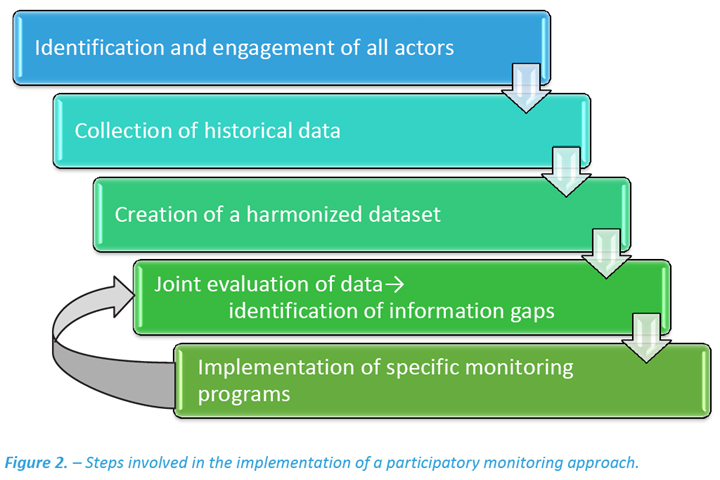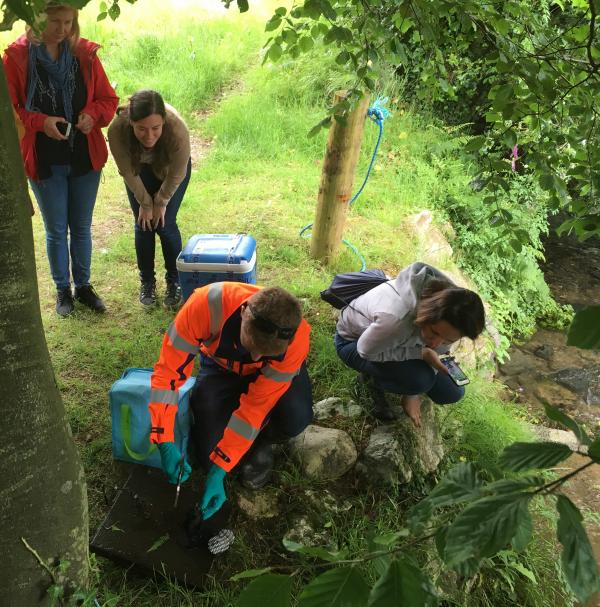The work package “Participatory monitoring” of our project aimed at establishing new approaches for the common collection of reliable water quality data by multiple parties in a catchment (Figure 1). The research and conclusions of the project work in this domain can now be discovered in the report “Guidelines for future, more efficient and sustainable participatory monitoring practices” (deliverable D3.3) by IDAEA-CSIC.

In the philosophy of WaterProtect, participatory monitoring is an essential instrument to raise awareness of the water quality problem and generate trust among all actors about the available data. It also facilitates the development of an efficient strategy to fight the pollution with better aimed mitigation actions and the promotion of the most suitable best management practices.
Overall, the monitoring programs resulting from the participatory monitoring process have three main objectives:
1. identifying priority pollutants in water and pollution sources
2. delineating (groundwater) abstraction zones
3. evaluating the efficiency of mitigation measurements.
Data harmonization
The design approach of the specific monitoring programs in each case was performed after the compilation, harmonization, and evaluation of existing historical data, the identification of information sources and gaps, selection of the most relevant parameters in terms of water quality to be monitored, as well as of the most relevant and meaningful sampling locations in each area (Figure2) .
Customized approach
Since each action lab has a different nature and reality (in terms of location and environmental zone, land use (rural or mixed urban/rural), farming system, irrigation, catchment size, source of drinking water, pollution...), a customized participatory monitoring approach was adopted for every action lab in order to answer the questions and cover the most relevant information needs.

Different monitoring focuses
In those cases where no data on water quality was available at the start of the project an initial surveillance plan was established, while sites with already well stablished surveillance plans set up advanced targeted participatory monitoring plans with different objectives established on the basis of the information gathered during the first year of the project and the main gaps identified.
Thus, in some cases the monitoring plan performed aimed at producing the first data ever available for the area of study, as it is the case for certain pesticides in the vineyards of Italy (Val Tidone), whereas in others the objective was (i) to screen the area for plant protection products (PPPs) or nutrients in order to identify the most critical compounds and sites upon which focusing potential mitigation measures to improve the overall water quality of the zone, (ii) to evaluate the effect and contribution of rain events, erosion and/or runoff processes on pesticides loads, as in the Belgian or Irish action lab, (iii) to identify the source (either inorganic or organic) of nutrients pollution through isotopic analysis, as done in the Polish, Spanish and Italian action lab, (iv) to evaluate the efficiency of new best management practices (BMPs) implemented within the project, as done in various of the sites, or (v) to simply get involved additional actors, such as school children, in the monitoring, as performed in the Romanian action lab through the use of simple kits for analysis of nitrogen species in groundwater.
Conclusions
Despite the significant differences in the action labs and participatory monitoring approaches, the local lessons learned can be synthesized in the following set of general guidelines for the design of a participatory monitoring approach in catchment to protect drinking water resources from pollution derived from agriculture or other human activities.
• Each catchment has its own nature and circumstances and therefore a specific participatory monitoring process will only fit the catchment for which it was designed.
• The realization is subject to economical funding to some extent and also the designation of a leader to drive the process.
• The engagement of all water actors in this process is crucial (linked to economical funding).
• Water quality data in the area need to be harmonized for successful integration and evaluation.
• The results of each monitoring program have to be evaluated by all water actors engaged in the process to set the objectives of future monitoring programs and measures.
• Joint examination of data is essential to understand each other’s needs and positions and elaborate management plans that benefit all actors.

